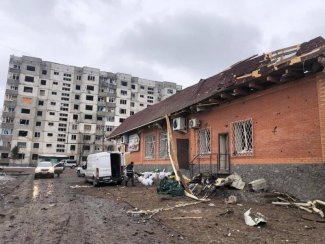The Russian attack on Ukraine: day 14

The military situation did not change significantly during the fourteenth day of the Russian aggression against Ukraine. The Ukrainian Armed Forces held back the offensive in all directions, and the fighting took place mainly on the outskirts of the towns & cities under attack. According to Kyiv, the Russian army will mobilise reserves it has at its permanent locations and move more units into Ukraine. The Ukrainians have emphasised the important role Belarus has played in securing the logistics of the attack.
In the Polessie direction, most clashes are taking place in the vicinity of Kyiv, and the forces prepared to defend the city remain ready to repel any possible strike. On 9 March, Russian troops regrouped to attack the capital and rotate their sub-units on the front line, which the Ukrainians took advantage of to launch attacks on Borodianka and Makariv. This assault ended with the opponent suffering some losses, but did not change the occupied positions. South-west of Kyiv, the aggressor’s troops continued their offensive actions in the Fastiv region, but the defenders were apparently able to repel the attack on Fastiv town.
In the Severny direction, the main battles are taking place on the north-eastern outskirts of Kyiv and in the town of Brovary. One of the invaders’ battalion tactical groups (BTGs) organised a crossing of the Trubizh River (the left tributary of the Dnieper) to block the E95 route (the main exit road from Kyiv to the northeast) 10 km from the capital’s borders. Particularly heavy clashes took place on the outskirts of Brovary. A Russian attack near the villages of Bohdanivka and Velyka Dymerka (30 km north-east of Kyiv’s city centre) was halted. Due to the losses suffered near Chernihiv, the aggressor engaged a reserve BTG from the 55th Mechanised Brigade of the 41st Combined Arms Army of the Central Military District. The towns of Sumy, Okhtyrka and Trostsyanets were bombed once again. All roads in the direction of Sumy and Trostsyanets were blocked due to the movement of the invader’s columns.
In the Slobodka direction, the Russian forces created a border along the Severodonetsk-Sumy line, from where operations are being launched westward to the line of the Dnieper and in the Kharkiv region. Particularly fierce fighting is taking place around the latter: the Russians have continued bombing and artillery fire, but the Ukrainian army regained full control of the town of Derhachi which borders it from the north. In the south, the aggressor expanded its attack zone to the west of Izyum (which was almost completely destroyed) up to the villages of Petrivske and Hrushuvakha.
In the Donetsk direction, Russian forces (numbering up to 7 BTGs) are continuing their efforts to push the Ukrainian forces to the western borders of Luhansk oblast and the northern borders of Donetsk oblast. After regrouping, they resumed their attacks on Severodonetsk and Rubizhne, and after taking control of the Starobelskiy region, they reached the town of Svativ (55 km north of Severodonetsk). Fearing encirclement, the defenders pulled out from the front line and retreated westwards. In Donetsk oblast, after partially reaching the border with Zaporizhzhia oblast, the aggressor moved its forces northwards and started firing at the villages north of Horlivka; fighting also took place in Maryinka (30 km west of Donetsk). In the vicinity of the besieged city of Mariupol, the most severe clashes took place along the ‘green corridors’, intended for the evacuation of the population.
In the Taurida direction, the line of the offensive has begun to move north. The aggressor’s troops were halted in Novovorontsivka on the right bank of the Dnieper, 60 km south-east of their target, the city of Kryvyi Rih. In the Zaporizhzhia region, the invaders reached Rozivka, 45 km north-west of Mariupol. Mykolaiv remains encircled, and Russian forces have occupied the northern districts of the city. To its northwest, the Ukraine Armed Forces have designated a new defence direction, the Southern Buzhany. Ukrainian troops are still holding back the Russians in the vicinity of Voznesensk; a Russian attempt to cross the Boh River failed, which forced them to stop their move towards the South Ukrainian Nuclear Power Plant.
The Ukrainian Defence Ministry has stated that the Russian offensive is being effectively checked. Some of the aggressor’s units have lost their combat effectiveness, which has forced them to call up additional reserves. The role of local territorial defence formations and voluntary units is growing in importance. The Ukrainian government is calling on the public to focus on destroying Russia’s electronic warfare and electronic reconnaissance systems, as well as fuel and supply columns. President Volodymyr Zelensky signed a law on ensuring the participation of civilians in the defence of Ukraine, which provides the legal basis for the spontaneous organisation of ‘total defence’, including the right of residents to receive firearms and ammunition. Civilians have been released from criminal liability for the use of firearms against the aggressor.
The foreign minister Dmytro Kuleba warned that as power to the closed Chernobyl power plant (where spent nuclear fuel is stored) has been cut, there is a risk of a radioactive leak. He called for a maintenance brigade to be admitted to the facility to restore power, as the standby diesel generators were designed to run only for 48 hours. The Ukrainian operator Ukrenerho has announced that it will start repairs to the transmission line, despite the risk of Russian shelling. Belarus’s president Alyaksandr Lukashenka, after talking with Vladimir Putin, said that Belarus was investigating the possibility of supplying Chernobyl with its own electricity.
The Russians are continuing their efforts to pacify the occupied territories; these moves will take the form of criminal operations supported by the FSB. In the Kherson region, the National Guard detained over 400 Ukrainians on charges of resisting and participating in anti-Russian demonstrations. Psychological actions to lower the morale of the civilian population are underway. In occupied Berdyansk, the locals are being offered the possibility to obtain Russian passports. Russian forces are terrorising local journalists and forcing them to spread disinformation. In Melitopol, it has been announced that the annual seeding campaign will be launched, with assurances that the local farmers will have access to the Russian market. Alleged receptions of Russian humanitarian aid are being staged, performed by stooges.
For the first time, Russia admitted that its military operation has been poorly prepared, and that it had sent soldiers to Ukraine from the autumn conscription, who were untrained for combat operations. It was confirmed that many young soldiers have been taken prisoner. This caused a sharp reaction from Putin, who ordered the recruits to withdraw from Ukraine, and instructed the military prosecutor’s office to indicate the persons responsible for making such a decision.
The Russian defence ministry claims that 2911 Ukrainian military infrastructure facilities, 97 aircraft, 107 unmanned aerial vehicles, 141 anti-aircraft missile systems, 86 radar stations, 986 tanks and other armoured combat vehicles, 107 multiple rocket launchers, 368 artillery & field mortars and 749 wheeled vehicles have been destroyed since the beginning of the operation.
More than 45,000 people were evacuated from zones affected by hostilities (including Sumy, Enerhodar, Hostomel, Borodianka, Bucha). They were taken to a refugee camp which has been set up at a training ground near Kyiv. According to their accounts, the Russians have been plundering stores, intimidating and murdering the inhabitants. The condition of the besieged city Mariupol is disastrous; people are dying due to the lack of water, electricity and food – the city authorities estimate that 1300 residents have died as a result of the blockade and shelling. Moreover, on 9 March the aggressors bombed a maternity hospital and are still preventing humanitarian convoys from entering the city, as well as blocking the evacuation of the population.
On 9 March, 117,000 people crossed into Poland; in total 1.43 million have entered the country since the beginning of the invasion. Evacuation trains run by Ukrainian Railways have already transported 1.8 million people from the east and south of Ukraine to its western regions, and a further 147,000 have been transported abroad. Once again, the number of connections to Poland and the Czech Republic has been increased. In Lviv and Ivano-Frankivsk oblasts, as well as in Odesa, schools and universities are resuming work (remotely) as of 14 March.
The European Bank for Reconstruction and Development will provide Ukraine with €2 billion (deferred repayment of loans, liquidity support for companies, assistance in relocation), and will subsidise municipal services in the countries receiving refugees. The US House of Representatives has approved US$13.6 billion in support for Ukraine, which is to be allocated to military, economic and humanitarian aid (although this initiative must receive the backing of the Senate).
On 10 March, the foreign ministers of Russia and Ukraine, Sergei Lavrov and Dmytro Kuleba, met in Antalya in the presence of Mevlüt Çavuşoğlu, the head of the Turkish foreign ministry, who acted as an intermediary. According to the Russian side, the talks were mainly about humanitarian problems, as Moscow insists that negotiations aimed at settling the conflict should only be conducted between the Ukrainian and Russian delegations in Belarus. Lavrov revealed that in these negotiations, the Russians handed the Ukrainian delegation a draft document defining the terms of the ceasefire, and are waiting for Kyiv’s response. He also reiterated his previous position regarding the need to ‘demilitarise and de-Nazify’ Ukraine, and at the same time stated that there was no Russian attack on Ukraine. When answering questions about the bombing of the Mariupol maternity hospital, he claimed that the building had been turned into a resistance point by the Azov battalion and other radicals, and that patients and staff had been evacuated. Kuleba announced that the most important things for the Ukrainian side at this time were to arrange an at least temporary ceasefire and agree upon humanitarian corridors. He also rejected any possibility of surrender. According to a poll conducted on 3-4 March, 79% of Ukrainians oppose recognising the occupied territories of Donbas as part of Russia, 75% oppose the formal cession of Crimea, and 56% reject the Russian demand that Ukraine cannot become a member of NATO.
Commentary
- In most directions, Russian offensive operations have turned into positional combat, in which the aggressor attempts to encircle Ukrainian forces in the main urban centres and displace them from the smaller towns. However, this does not mean the Russians have given up launching further attacks: these are still being launched from the east to the line of the Dnieper (to Kaniv and Dnipro city), and from the south to Zaporizhzhia (regular Ukrainian forces have been forced out of the southern part of Zaporizhzhia oblast). The action halting the Russians’ advance along the Boh river coincided with their launch of an attack from the side of Kherson towards Kryvyi Rih. The Russian troops attacked at a high pace, which indicates the weakness of the defence along the right bank of the Dnieper. The Ukrainian forces have formed their main line of defence across practically the entire width of Mykolaiv oblast.
- The clashes on the outskirts of Kyiv, Kharkiv and Mariupol are still exceptionally fierce. The defenders’ determined attitude has been strengthened by Russian air & artillery attacks, producing a high number of casualties among the civilian population, as well as the Russians’ consistent violation of promises regarding the so-called humanitarian corridors, which the aggressor’s troops have been using to try to break the lines of defence. The invaders are pushing the defenders back at a pace of around 10 kilometres a day, but on the tactical level they have also encountered effective counterattacks. They will strive to fully close the encirclements of towns & cities where this has not yet happened, and to push the Ukrainian troops all the way into the built-up areas, regardless of how many losses they suffer. It is only a matter of time before the second strategic echelon units, which will replace those currently fighting in Ukraine, will be launched.
- The Kuleba-Lavrov negotiations were used by the Russian side to demonstrate its tenacity towards Kyiv, and to send a signal that Russia intends to continue its aggression until Ukraine capitulates. It seems that Moscow mainly participated in the talks to show its alleged good intentions to its own society, and as a kind of gesture towards Ankara, which has persistently offered its mediation. The Ukrainian side only confirmed that it is interested in holding talks on ending the aggression, but does not intend to capitulate.
- Putin’s order that the military prosecutor’s office find the people responsible for sending the troops from the autumn conscription to Ukraine is a signal that part of the military operation was badly prepared. His disapproval of the steps taken by the senior command of the Russian armed forces shows that he will try to pass the blame for the military’s failure to achieve any spectacular success onto the army’s commanding cadres.
- The actions of the occupying forces are proving largely ineffective. Their psychological and disinformation operations have not had any success; the local population still has a hostile attitude towards the aggressor, and there have been no signs that the local people are collaborating voluntarily. Russia’s information policy remains defensive; it is mainly targeted at its own people, and aims to maintain a false image of the war. The invaders have deliberately impeded the evacuation of the besieged cities, even firing upon the agreed ‘green corridors’, and have kept up the blockade of Mariupol for over a week. However, the Russian strategy of escalating repression and barbarity against the civilian population is not boosting the desire for capitulation in Ukraine, but instead is consolidating rage at the occupiers.
- The Ukrainian government attaches increasing importance to involving civilians in resisting. The enactment of the law allowing every inhabitant of the country to fight with weapons in hand means that Kyiv has not given up on continuing the struggle in the form of ‘total defence’. The morale of society remains persistently high in its determination to defend the country (93% of the inhabitants believe in their ultimate victory), and so the civilian population’s participation in destroying Russian forces will make it difficult for the enemy to move.




